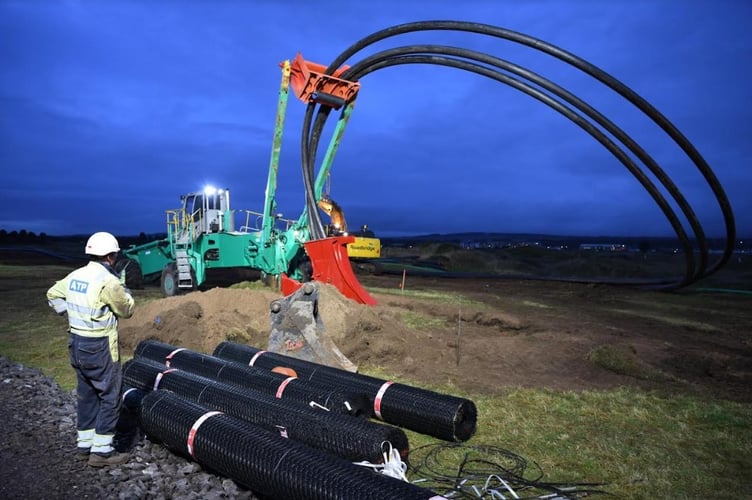A group campaigning against pylons and overhead transmission lines in Carmarthenshire’s Towy Valley believes an answer could lie on the doorstep.
Llanarthne Area Community Pylon Group wants power lines from a proposed wind farm in Powys to a grid connection point 90km away, near Carmarthen, to be buried underground to protect the landscape.
It would like the energy company behind the proposal – Green GEN Cymru – to consider using a technique called cable-ploughing. This involves moving machinery cutting a slit in the ground and laying a cable or duct as it goes along with the disturbed ground flattened and reinstated as part of the process. The completed route is then mapped with a GPS system.
A company called ATP, near Carmarthen, specialises in this type of ploughing and said it can lay a kilometre of 132kV (kilovolt) cable – sometimes more – in a day.
Green GEN Cymru has said that the cost of burying cables was vastly more expensive than overhead pylons but Jon Daniels, of Llanarthne Area Community Pylon Group, questioned this given the cable-ploughing method.
“We feel that this technology can really be a solution here,” said Mr Daniels. “The controversy over pylons can be greatly diminished or even eradicated if people took a serious look at it.”
He believed landowners in the Towy Valley would also be far more receptive to cable-ploughing than the assembly and erection of pylons on their fields.
Mr Daniels said the action group was very keen to ensure that up-to-date cost comparisons between the various approaches were carried out. “Surely we need to know,” he said. Green GEN Cymru’s initial consultation on its Towy Usk power line proposal led to more than 2,500 responses.
ATP has laid cables, ducts and pipes in the UK and Europe, including in sensitive landscapes in England, using specialist “spider” ploughs. It has also buried cables for wind farm projects in Scotland. Ben James, operations manager at ATP, said rocky ground and steep slopes were negotiated in Scotland and that up to 1.4km of cable was laid per day of similar voltages.

ATP said it can deal with streams and rivers up to 1.8m deep and even lift up and replace sections of hedge.
Deep rivers would likely need to be horizontally drilled by a separate company while road crossings would involve diggers excavating the road and placing a pipe in the ground in preparation for cabling to be inserted.
It is understood that the limited time required on site and the low level of disruption associated with cable-ploughing could mean developers saving money because compensation to landowners would be less.
ATP said all in all the costs of ploughing could be significantly lower than the traditional open trench method of burying cables, which requires more excavation, and broadly similar to the use of pylons and overhead power lines.
Mr James said he acknowledged the efforts of campaigners in the Towy Valley who wished to protect the landscape. “The fact is that this method is tried and tested,” he said, referring to cable-ploughing. “Landowners would open their gates to it – with pylons that’s a different story.”
He said ATP, which has 17 employees, didn’t encounter resistance to cable-ploughing on its Scottish wind farm projects. “Members of the community, especially farmers, love coming out to see the kit working,” he said.
Mr James said cabling equipment was sophisticated and that it could be laid to clients’ specification and overcome hard ground conditions. Any faults could be identified and located using specialist equipment which sent a pulse along the wires.
The UK needs more wind and solar farms and nuclear power in the coming years to meet low-carbon energy targets and the demand on the grid will only increase the more transport, industry, and domestic heating are electrified to reduce carbon emissions.
System operator National Grid said it was overhauling the electricity grid in England and Wales in part to handle what is expected to be a continuing surge of offshore wind capacity.
It said that in the next seven years more than five times the amount of electricity transmission infrastructure will be needed than has been built in the last 30 years.
Renewable energy trade body RenewableUK Cymru said Wales needed to quadruple its wind power in just over a decade in order to stay on track to meet the Welsh Government’s target for electricity to be 100% renewable by 2035.
Last November the UK Government said householders living close to new pylons and electricity substations could receive up to £1,000 a year off energy bills for a decade as part of plans to expand and speed up the delivery of new infrastructure.
Last week Green GEN Cymru announced plans for another set of pylons to link a proposed wind farm from near Lampeter to a grid connection south of Carmarthen – a scheme called Green GEN Towy Teifi.
Carmarthen East and Dinefwr MS Adam Price and MP Jonathan Edwards have called for underground cabling to be the default way for connecting new renewable energy projects to the grid. The duo said: “We’ve seen a proposed route through the Towy Valley and now we have here an indication that the Teifi could follow suit. The local feeling on this matter is clear – these lines need to be put underground.”
A Welsh Government spokesman said: “Updating Wales’ grid is essential if we are to have an energy system fit for purpose in the long term. Our planning policy states that wherever possible lines should be laid underground.”
Speaking last November climate change Minister Julie James said establishing whether cable-ploughing was technically possible for the largest power lines would be important in understanding whether ‘undergrounding’ could be more extensively adopted. In response RenewableUK Cymru director Jess Hooper said renewable energy companies were exploring a range of options and that it was essential that green energy infrastructure was designed and routed sensitively, with host communities benefiting directing where possible.
“As a sector we would emphasise the long-term need to ensure operating costs are also a consideration,” she said. “The technical specification for underground cables is likely to be more substantial, costly, and environmentally disruptive to maintain and repair.”
Green GEN Cymru, which is part of Bute Energy, is in the process of a finalising a detailed design and alignment of its Towy Usk transmission line proposal – including potential positions of pylons – as well as information on technology choice and other infrastructure that may be required.
Further consultation will follow before it submits an application for what’s known as a development of national significance. Welsh ministers will have the final say on the project.
Asked if had been looking into the options for burying the cables underground, and if so what it had found out in terms of cost and feasibility, Green GEN Cymru said: “We are committed to keeping our impact on local communities to a minimum and as we evolve the design and routing of the project we are also speaking to contractors and other companies to explore innovative technical options – including ways of installing cables underground that may be cheaper than traditional methods.”




